
The LONDON area 2.5ton Dennis buses: DS
This page created 15th November 2020 using Notepad, by Ian Smith.
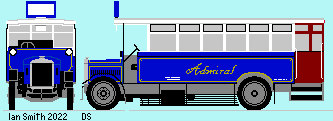 The 2.5 ton Dennis was the small twenty-five seater of choice in 1924-1926 - for north London Independents at least. These lttle buses introduced pneumatic tyres on buses to the streets of London.
Route 280 was approved by the Police from May 1925. It operated initially between Finsbury Park and Enfield,
extended a month later to Forty Hill. Traffic demand meant it transmogrified into the 538 from September 1925, operating the same route extended to Stroud Green and Forty Hill. Admiral purchased twelve 25 or 26-seater Dodson-bodied buses in blue/white livery for the route. Redburn's bought six in July 1925, with Strachan & Brown 26-seater bodies in red/white. They were put into use on the 280, which soon became the 538, jointly worked with Admiral.
The 2.5 ton Dennis was the small twenty-five seater of choice in 1924-1926 - for north London Independents at least. These lttle buses introduced pneumatic tyres on buses to the streets of London.
Route 280 was approved by the Police from May 1925. It operated initially between Finsbury Park and Enfield,
extended a month later to Forty Hill. Traffic demand meant it transmogrified into the 538 from September 1925, operating the same route extended to Stroud Green and Forty Hill. Admiral purchased twelve 25 or 26-seater Dodson-bodied buses in blue/white livery for the route. Redburn's bought six in July 1925, with Strachan & Brown 26-seater bodies in red/white. They were put into use on the 280, which soon became the 538, jointly worked with Admiral.
Admiral also used a Dennis on the 353 (Totteridge-Wood Green), which it took over from Barnet Motor Services in December 1926. Its continued operation on the 353 for the year to December 1927 was probably illegal, as transfer of routes between operators was not permitted. It then went to Waltham Motor Services, where it worked the 306B (Waltham Cross-Waltham Abbey), alongside another new Dennis. Another route for the 2.5 tonners was the 551 (Whetstone-Edmonton (Sparklets Works)). This was worked by Redburn's, BB, HHC, SB, and Silver Star, with other types from other small independents. HHC was not content with the 551 and used his buses on other independent routes in succesive months in the spring of 1927: the 182 in March, 100A, 100F (April), 263 (May) before operating in the early summer unlicensed.
A short but useful route was the 297 (Tuffnell Park - Kings Cross), worked by Clarendon with a pair of 1925 Dennis 2.5 ton buses with Dodson 25-seat bodies. The route extended to Charing Cross in December 1925, becoming the 297A. PHRH of Stockwell joined Clarendon on the 297 after experimenting unsuccessfully with the 547 (Ladbroke Grove - Ebury Street) Route 550 (Finsbury Park - Islington) was taken up by three companies from early 1926. The Orange Bus Service bought on hire-purchase four Dodson-bodied Dennises which it painted orange/white. Nulli Secundus and Dauntless each had one, painted red/white, but these were quckly sold on to Orange, presumably because route 550 was not as profitable as first expected. All six buses were repainted in December in orange/black. The London Public Omnibus Company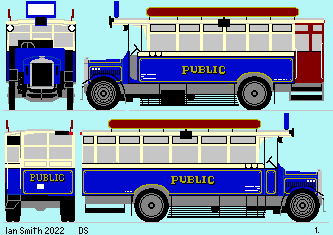 1927 was a year of mass change for the operators of the small Dennises in London. London General (the LGOC)
was aggressively taking over whatever bus companies that were finding the going difficult under the terms of the the London Traffic Act. The LGOC would not keep on any men over the age of 55, nor anyone who had previously worked for the LGOC,
and no-one wanted to be unemployed in the aftermath of the 1926 General Strike. In July 1927 a new company was set up: the London Public Omnibus Company. It offered to buy bus companies for about twice the price per bus that the LGOC was offering, and build a bulwark against the encroaching General. It was promulgated by A.T. Bennett, owner of Admiral, and a highly respected Independent. It did not reveal that its funding came from the LGOC. In August it took over most of the remaining small Dennis operators. All the others succumbed to the LGOC either earlier or later. In 1927 such acquisitions required the fleetnames to be retained, even if buses could be repainted in LGOC fleet colours. This was relaxed in January 1928, when the LGOC was able to fully absorb the companies. Public was been revealed for what it was in March 1928: a front for the General. But now it had an extensive fleet of the small single-deckers, which mostly remained in service on the same routes as before. They received numbers in Public's DS series, and Public livery.
1927 was a year of mass change for the operators of the small Dennises in London. London General (the LGOC)
was aggressively taking over whatever bus companies that were finding the going difficult under the terms of the the London Traffic Act. The LGOC would not keep on any men over the age of 55, nor anyone who had previously worked for the LGOC,
and no-one wanted to be unemployed in the aftermath of the 1926 General Strike. In July 1927 a new company was set up: the London Public Omnibus Company. It offered to buy bus companies for about twice the price per bus that the LGOC was offering, and build a bulwark against the encroaching General. It was promulgated by A.T. Bennett, owner of Admiral, and a highly respected Independent. It did not reveal that its funding came from the LGOC. In August it took over most of the remaining small Dennis operators. All the others succumbed to the LGOC either earlier or later. In 1927 such acquisitions required the fleetnames to be retained, even if buses could be repainted in LGOC fleet colours. This was relaxed in January 1928, when the LGOC was able to fully absorb the companies. Public was been revealed for what it was in March 1928: a front for the General. But now it had an extensive fleet of the small single-deckers, which mostly remained in service on the same routes as before. They received numbers in Public's DS series, and Public livery.
In February 1929 Public made a swap of routes with the General. Amongst the routes transferred were DS operated 297 (Tuffnell Park - Kings Cross), the 263A and 263B (Finsbury Park - Chingford). This concentrated Public's DS buses on West Green (WG) and Enfield (E).
The London General Omnibus CompanyMeanwhile LGOC had also taken over a fleet of Dennis 2.5 ton buses, which it numbered in its D series. These buses remained largely un-noticed, un-photographed and unrecorded. Some were transferered to National at Watford.Amersham & District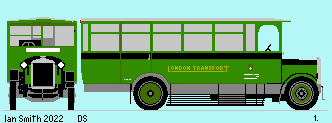 Up to 1925 Amersham & District Motor Bus & Haulage Co.Ltd had used a variety of small and tiny buses on a fairly quick turnover, competing with National and Aylesbury. In 1925 it set about making itself both competitive and profitable, buying five Dennis 2.5tonners during the course of the year, with Strachan & Brown bodywork of slightly varying sizes. They were complemented by a Dennis 4-ton bus. With these the company established a network of routes spreading out from Chesham Broadway along the Chiltern ridges - a network that would seem familiar to devotees of GS buses forty years later. The company quickly began to pay a sizeable dividend, attracting the attention of the LGOC. That did not buy the company outright, but did buy a 50% stake
that allowed the company to expand profitably. The five little Dennises continued to operate until taken over by London Transport in November 1933, working until replaced by Leyland Cubs in 1936.
Up to 1925 Amersham & District Motor Bus & Haulage Co.Ltd had used a variety of small and tiny buses on a fairly quick turnover, competing with National and Aylesbury. In 1925 it set about making itself both competitive and profitable, buying five Dennis 2.5tonners during the course of the year, with Strachan & Brown bodywork of slightly varying sizes. They were complemented by a Dennis 4-ton bus. With these the company established a network of routes spreading out from Chesham Broadway along the Chiltern ridges - a network that would seem familiar to devotees of GS buses forty years later. The company quickly began to pay a sizeable dividend, attracting the attention of the LGOC. That did not buy the company outright, but did buy a 50% stake
that allowed the company to expand profitably. The five little Dennises continued to operate until taken over by London Transport in November 1933, working until replaced by Leyland Cubs in 1936.
Penn Bus CompanyThe Penn Bus Company, from the village of Penn near High Wycombe, developed from a horse bus service into High Wycombe. A period with Model T Fords gave way to something rather more substantial with the purchase of a Dennis 2.5tonner with Strachan & Brown 20-seater body in January 1924. This was to provide competition against Thames Valley on the route to Great Missenden. Its big advantages were its capacity and its pneumatic tyres, which allowed a higher top speed and quicker journeys. A second, in July 1924, took over from a Ford T-type on the service from Penn to High Wycombe. Two more, slightly larger at 25 seats, came at the end of 1924 for a February start on the service from West Wycombe to Loudwater and Wooburn Green, where growing traffic made the Fords too small. (The Fords were not thrown out at this stage, but used to start further local services.) 1925 saw three more 2.5tonners acquired - 5, 7 and 8 - not all at once, but spaced out - for replacement of the Fords. Slightly different was No.6, a 30cwt Dennis with a narrow 16-seater body for use on a narrow route from High Wycombe to Naphill. No9 in July 1926 was another replacement bus. After that Penn turned to Chevrolet for its small buses for the next year. Some of the early buses were rebuilt or rebodied with front entrances. Four more 2.5 tonners followed between July 1927 and January 1929. After that the company was buying bigger buses.
When London Transport came on the scene in 1933 Penn was straddling the boundary of the new Country Area, part being within LT's zone and the rest falling to Thames Valley. Wrangling over the takeover price dragged on into 1935. LT took just one of the little Dennises (No2), and Thames Valley took five.
|
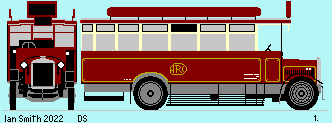 The 263 (London Fields - Leyton) was taken on by ARO from June 1926, initially with three buses. Three more followed in August and another at the end of the year. Havelock also expanded its operations by putting five Dennises onto the 263, three in June and another two in December 1926. These (ARO and Havelock) also worked from Leyton to Clapham Common on Sundays as the 555.
The 263 (London Fields - Leyton) was taken on by ARO from June 1926, initially with three buses. Three more followed in August and another at the end of the year. Havelock also expanded its operations by putting five Dennises onto the 263, three in June and another two in December 1926. These (ARO and Havelock) also worked from Leyton to Clapham Common on Sundays as the 555.
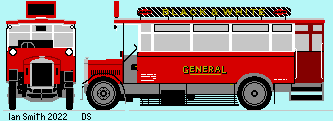 Public was finally absorbed by General in December 1929. Some of its Dennises survived into the London Transport fleet in 1933. LT used four on Enfield's route 204, which was too narrow for other buses until the advent of Cubs in 1936.
Public was finally absorbed by General in December 1929. Some of its Dennises survived into the London Transport fleet in 1933. LT used four on Enfield's route 204, which was too narrow for other buses until the advent of Cubs in 1936.
 Ian's Bus Stop
Ian's Bus Stop DS main text.
DS main text. DS histories
DS histories